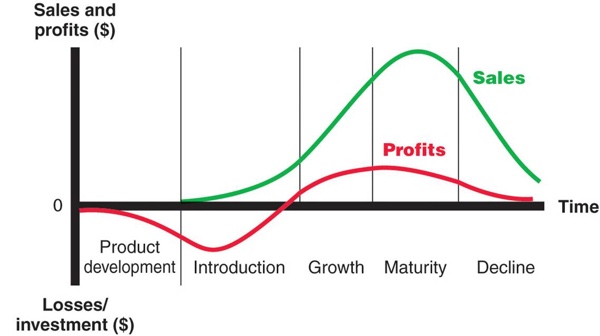The 5 stages in the product life cycle (PLC) curve
In a similar way to how our economy goes through the stages of recession, followed by recovery and ultimately back to prosperity (the Economic Life Cycle (ELC), products also have their own unique life cycle. This concept is known as the Product Life Cycle (PLC) concept.
The product life cycle (PLC) theory considers a number of stages during the evolution of a product – over a period of time – typically from development through to possible abandonment. The five stages in the PLC concept generally include:
- Development;
- Introduction;
- Growth;
- Maturity; then
- Decline.
Small businesses must understand that the product life cycle curve is not generic. Simply by analysing a product’s position on the curve, marketing mix tactics can be devised and implemented that can reinvigorate the product. These changes to the marketing mix can bring product back into the growth phase, thus extending its existence.
Here’s what the curve may look like, with a brief description of each, following the image, below.
Development stage of the PLC
Product development is the earliest stage on the PLC curve. At this stage the product hasn’t yet been commercialised. During this phase the product is usually (but not always) incapable of generating revenue or profit for the business. However, costs associated with development of the product are frequently high.
Introduction stage
This is the stage at which the product is introduced to the market. Consumer or business buyer awareness of the product is usually low at this point. Here, companies work hard to gain market penetration. Gaining market acceptance is time-consuming, labour intensive, involving significant promotion, and this can be incredibly expensive.
Growth stage
The growth stage of the product life cycle is when the product experiences increased sales momentum. During the growth stage the product is experiences growth through market embracement, as well as increased distribution intensity. Sales volume and profit during this phase accelerate.
At this point, successful products are often ‘pulled through’ distribution channels by end-users. For example, an automotive accessory retailer, such as Autobarn, might have had numerous enquiries from consumers specifically asking if they sell a certain brand of car stereo. Not stocking these, the retailer actively seeks out the supplier of this brand for the purpose of stocking the in demand product.
Maturity stage
The time it takes for a product to reach the maturity stage differs dramatically from one product to another. Some products can peak very rapidly. Fashion clothing and footwear is a prime example. This means that their life expectancy on the product life cycle curve can be short, as they tend to enter the decline phase much sooner.
Sales and profit during the maturity phase stabilise – that is, the product is no longer showing signs of growth, but equally it hasn’t started its sales descent, either.
Decline stage
Unless obsolescence (product kill-off) is planned, the goal for marketers in the decline stage is to implement tactics, which delay their products from progressing into this stage. By taking action, such as the examples below, the marketer can considerably alter the length of a PLC curve. This action can return the product to the growth stage.
- increasing promotional efforts;
- further penetrating existing markets;
- entering new markets;
- Implementing a dual distribution strategy;
- adding value to the current product; or by
- reducing the product’s price to stimulate sales volume.
Product Life Cycle and Product Abandonment
Realistically, one could classify the stage of possible abandonment as the sixth stage in the product life cycle concept. Nothing lasts forever. There will come a point where a product’s sales volume and profit will decline. At this stage, small business managers must consider if the effort and resources required to keep the product ‘alive’ are justified. The key question to consider: “Is the product still financially viable?” Or, in other words, management must decide whether to continue investing in the product or divest.
Test your knowledge!
The article, above, is based upon tangible products. That is, physical products that we can physically touch. Examples include fashion footwear, refrigerators and smartphones.
Question: Does the PLC concept apply to services? For example, would a Gold Coast Bathroom Renovations company’s specialised services go through the stages discussed above?


